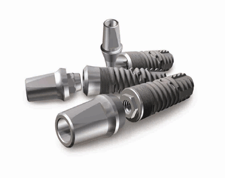المقالات
Upper Jaw

Some people just aren't able to comfortably wear an upper denture. It doesn't stay in place, it gags them when they talk or chew, or it hurts constantly. The transition from their own teeth to an upper denture just never worked out. If you're one of these people and you'd love to get rid of your upper denture, then implants may be the answer.
Dental implants are small titanium cylinders that are surgically inserted into the bone of the jaw to replace the roots of missing teeth. Bone in the upper jaw is continually lost once teeth have been removed. Implants help to stabilize the bone.
There are several ways to use implants in the upper jaw to replace a denture. One way is with a modified denture that's open on the palate. The denture clips to a bar that connects the implants. You can take it in and out by yourself at home. Another option is a bridge that may be cemented in place or secured by screws.
Replacing your missing teeth with dental implants and restorations can make a world of difference. You can eat, talk, laugh, and smile with confidence again.
Restoring your upper jaw with dental implants is accomplished in two phases. The first phase of the procedure is the surgical placement of the implants. They're under the gums for several months while the bone attaches to them. After healing, the second phase begins. The implants are re-exposed and your new teeth are made.
For the surgical placement of the implants, your mouth will be thoroughly numbed. Incisions are made in your gums and channels are made in the bone to receive the implants. After the implants are snugly in place, the gums are closed over each implant with a stitch or two. Over the course of the next few months, the implants become securely attached to the bone.
The second phase starts with surgical re-exposure of the implants. Incisions are again made in your gums, and small extensions are placed to bring them above the gum line. We then start a series of appointments to make your new teeth. Though some of the steps might be different in your case, they usually include making impressions of your mouth. From these impressions, we make precise working models of your mouth, which are carefully mounted for proper alignment. It's on these models that your new teeth are fabricated. The last step is the placement of the teeth.
The success of your implants then depends on your care of the implants at home and our support through regular checkups and cleanings here in our office.
